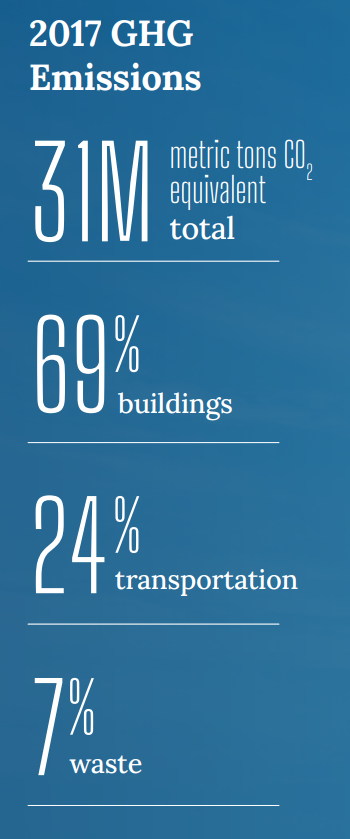Electrify Chicago
An independent tool for viewing City of Chicago building data
According to the
2022 Chicago Climate Action Plan,
69% of Chicago's emissions come from buildings, making
building emissions our biggest challenge and our biggest opportunity as a city
to tackle climate change. At Electrify Chicago, we showcase building performance using
publicly available data supplemented by community-submitted photographs and building
owners.
Start by looking at Chicago's buildings with the highest greenhouse gas intensity i.e. emissions per square foot. Large, efficient, buildings can perform much better than very inefficient small buildings on this metric.
New Article
📰 $30 Million In Missed Fines
The City Of Chicago failed to collect $30 million in potential fines from the building benchmarking ordinance, reducing transparency and accountability.
Legislative update! 🎉
As of late January 2024, legislation is being introduced to require new use more efficient forms of water and space heating, via the Clean And Affordable Buildings Ordinance (CABO), which will reduce the number of highly polluting and inefficient buildings that end up on this site.
If you're in Chicago,
write to your alderman to support the CABO!
Chicago Buildings by Greenhouse Gas Intensity
Note: Data includes large Chicago buildings with data from 2022, unless explicitly stated otherwise.
Note: This data only includes buildings whose emissions are reported
under the
Chicago Energy Benchmarking Ordinance. According to the City “As of 2016,
this list includes all commercial, institutional, and residential buildings larger than
50,000 square feet.” This dataset is also then filtered to only buildings with
reported emissions > 1,000 metric tons CO2 equivalent.
The latest year of data is from 2022, but we update the site regularly when new data is available, and some buildings may have failed to report that year, and only have older data available.
| Property Name / address | Primary Property Type |
Greenhouse Gas Intensity (kg CO2 eq./sqft) |
Total Greenhouse Emissions (metric tons CO2 eq.) |
|---|---|---|---|
|
Uptown Regency
5046 5052 N SHERIDAN RD
| Multifamily Housing | 8.1 kg/sqft
Highest 25%
| 939 tons
Highest 47%
|
|
920 W LAWRENCE AVE
🕰️
920 W LAWRENCE AVE
| Multifamily Housing | 8.1 kg/sqft | 1,204 tons |
|
Fordham Hall- ID# 103681
🕰️
(Loyola)
6427-6455 N Sheridan Rd
| Residence Hall/Dormitory | 8.1 kg/sqft | 924 tons |
|
13550 S AVENUE O
13550 S AVENUE O
| Senior Living Community | 8.1 kg/sqft
Highest 25%
| 489 tons
Lowest 25%
|
|
55 E Monroe
🚩
55 E Monroe St
| Office | 8.1 kg/sqft
Highest 25%
| 12,987 tons #41 Highest
|
|
Wright College
🕰️
4300 N Narragansett
| College/University | 8.1 kg/sqft | 4,384 tons |
|
73 E LAKE ST
73 E LAKE ST
| Multifamily Housing | 8.1 kg/sqft
Highest 25%
| 2,407 tons
Highest 19%
|
|
Pritzker Science Center
🕰️
3105 S Dearborn St
| College/University | 8.0 kg/sqft | 994 tons |
|
Luxe on Chicago
1838 W CHICAGO AVE
| Multifamily Housing | 8.0 kg/sqft
Highest 26%
| 558 tons
Lowest 31%
|
|
Halas Recreation Center- ID# 254386
🕰️
(Loyola)
6458 N WINTHROP AVE
| College/University | 8.0 kg/sqft | 976 tons |
|
WhirlyBall
1825 W WEBSTER AVE
| Other - Recreation | 8.0 kg/sqft
Highest 26%
| 403 tons
Lowest 17%
|
|
Gateway West Loop Apartments
11 S Green St
| Multifamily Housing | 8.0 kg/sqft
Highest 26%
| 1,071 tons
Highest 43%
|
|
Northwest Tower Apartments
1170 W Erie St
| Multifamily Housing | 8.0 kg/sqft
Highest 26%
| 1,119 tons
Highest 41%
|
|
UNO Roberto Clemente Charter School
2050 N NATCHEZ AVE
| K-12 School | 8.0 kg/sqft
Highest 26%
| 452 tons
Lowest 22%
|
|
Revere Elementary -CPS
(CPS)
1010 E 72nd St
| K-12 School | 8.0 kg/sqft
Highest 26%
| 652 tons
Lowest 37%
|
Data Source:
Chicago Energy Benchmarking Data
